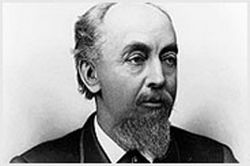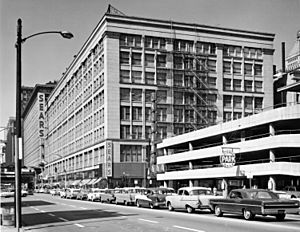William Le Baron Jenney facts for kids
Quick facts for kids
William LeBaron Jenney
|
|
|---|---|
 |
|
| Born | September 25, 1832 |
| Died | June 15, 1907 (aged 74) |
| Nationality | American |
| Alma mater | École Centrale Paris |
| Occupation | Architect |
| Buildings | Home Insurance Building in Chicago |
| Design | metal-framed skyscraper |
William Le Baron Jenney (born September 25, 1832 – died June 14, 1907) was an American architect and engineer. He is famous for building what is considered the world's first skyscraper in 1884. His ideas changed how tall buildings were made forever.
Contents
Early Life and Education
William Le Baron Jenney was born in Fairhaven, Massachusetts, on September 25, 1832. He started his studies at Phillips Academy and later at Harvard. However, he decided to move to Paris, France, to study engineering and architecture at the École Centrale Paris.
In Paris, Jenney learned about new ways to build with iron. He also studied the ideas of Jean-Nicolas-Louis Durand, a professor who believed buildings should be practical. Jenney graduated in 1856. One of his classmates was Gustave Eiffel, who later designed the famous Eiffel Tower.
A Career in Building and Design
In 1861, Jenney returned to the U.S. He joined the Union Army during the American Civil War. As an engineer, he helped design important forts for generals like Sherman and Grant. By the end of the war, he had become a major.
After the war, in 1867, Jenney moved to Chicago. He opened his own architectural office. He focused on designing buildings for businesses and planning city spaces. He also taught architecture at the University of Michigan. Many future famous architects, like Louis Sullivan and Daniel Burnham, learned from him.
Jenney married Elizabeth "Lizzie" Hannah Cobb in 1867. They had two children, Max and Francis. He was an important member of the American Institute of Architects. Some of his other notable designs in Chicago include the Ludington Building and the Manhattan Building, both built in 1891. He also designed the Horticultural Building for the World's Columbian Exposition in 1893.
Inventing the Skyscraper
Jenney is most famous for designing the ten-story Home Insurance Building in Chicago. This building, completed in 1885, is known as the first true skyscraper. It was the first building to have a full metal frame.

Before Jenney, most tall buildings used heavy brick and stone walls to support their upper floors. Jenney had a new idea: he used metal columns and beams instead. This made the building much lighter. A ten-story building made with his metal frame weighed only one-third as much as a similar building made of heavy stone. This new method allowed buildings to be built much taller than ever before.
There's a popular story about how Jenney got his idea. One day, he saw his wife place a heavy book on a small bird cage. The cage held the book easily. Jenney realized that if a small cage could hold a heavy book, then a strong metal frame could support an entire building! He used this idea for the Home Insurance Building.

Jenney also worked on making tall buildings safe from fire. He used materials like masonry, iron, and terra cotta for floors and walls. He showed how well his system worked when he built the Second Leiter Building in Chicago between 1889 and 1891.
Legacy
William Le Baron Jenney passed away in Los Angeles, California, on June 15, 1907. His work changed architecture forever, making it possible to build the towering skyscrapers we see today. In 1998, he was ranked among the "1,000 People Who Shaped the Millennium" in a famous book.
Projects
Jenney designed many important buildings and projects, including:
- Home Insurance Building, Chicago, built in 1884
- Horticultural Building, for the World's Columbian Exposition, Chicago, built in 1893
- Ludington Building, Chicago, built in 1891
- Manhattan Building, Chicago, built in 1891
- Second Leiter Building, Chicago, built in 1889
- Church of the Redeemer, Chicago, built in 1886
- Col James H. Bowen House, Hyde Park, Chicago, built in 1869
- Metropolitan Block, Lake Geneva, Wisconsin, built in 1874
- First Congregational Church (Manistee, Michigan), Manistee, Michigan, built in 1892 or 1888
- Lake Forest Cemetery, Lake Forest, Illinois
- L.Y. Schermerhorn Residence, Riverside, Illinois, built in 1869
- New York Life Insurance Building, Chicago, built in 1894
- West Park District section of Chicago's boulevard system
- DKE Shant, Ann Arbor, Michigan, 1878
- Part or all of Garfield Park, Chicago
- Part or all of Humboldt Park, Chicago
- Illinois Memorial, Vicksburg National Military Park, 1906
- Railway Exchange Building, Milwaukee, 1901
Images for kids
-
Chicago residence designed for Walter C. Newberry, 1889
-
Horticultural Building at World's Columbian Exposition
See also
 In Spanish: William Le Baron Jenney para niños
In Spanish: William Le Baron Jenney para niños



